Cathedrals tend to dominate the skyline of every city where they feature, beckoning in the faithful, and the curious alike. Often these imposing structures hide a lot from the casual onlookers, but look a little deeper and there is lots to uncover.
Seville’s cathedral, and its accompanying Giralda are no exception. Let us guide you through some of the many curiosities and facts about the world’s largest gothic cathedral.
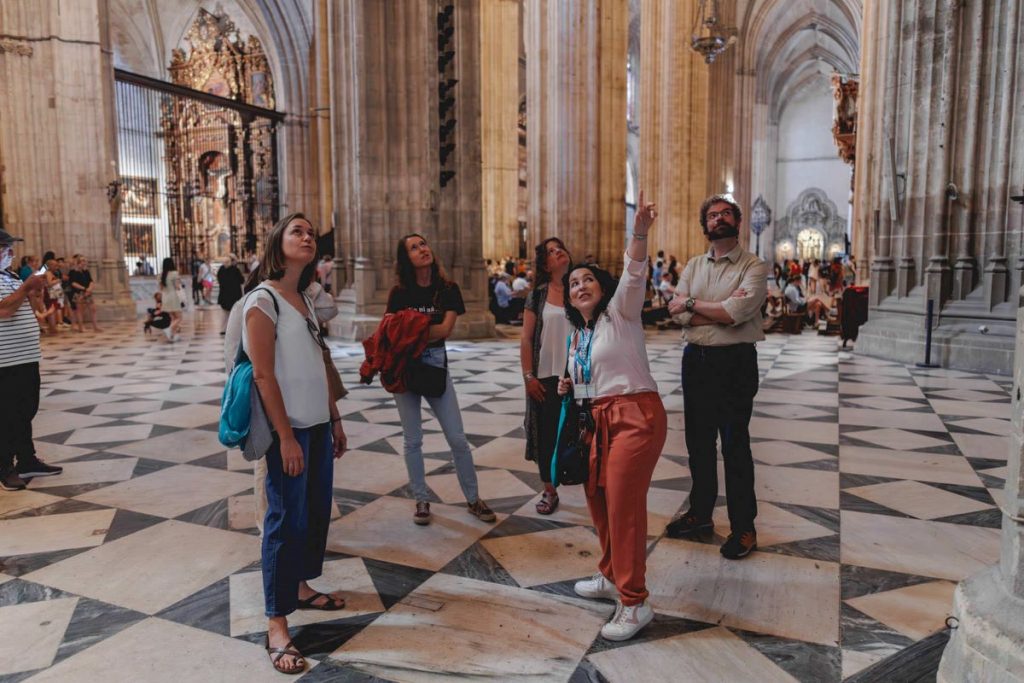
The Giralda
History of the tower
Dominating the skyline, the Cathedral’s tower is the symbol of the city. The Giralda was originally built as the minaret for the mosque that stood on the spot of the modern-day cathedral.
The original tower was completed in 1198 and looked quite different from what we can see today:
- It was adorned with four precious metal spheres to commemorate the victory over King Alfonso VIII of Castile at the battle of Alarcos in 1195.
- Following this victory, the Almodads only had control of the city until the reconquest reached Seville in 1248.
- From then, the great mosque was converted into a gothic christian cathedral. Look close at the tower and you will see the original Islamic geometric patterns, showing its almohad past.
The striking tower we see today was completed in 1506. It features two inscriptions:
- The first is TURRIS FORTISSIMA NOMEN DNI PROVERB 18, which refers to Proverb 18, The name of the Lord is a strong tower.
- The second is NO8DO. NO8DO is the motto of the city. The 8 is a madeja, a skein of straw or hay. When said quickly, no madeja do sounds like no me ha dejado– she [Seville] has not abandoned me. You’ll see this symbol scattered all over the city.
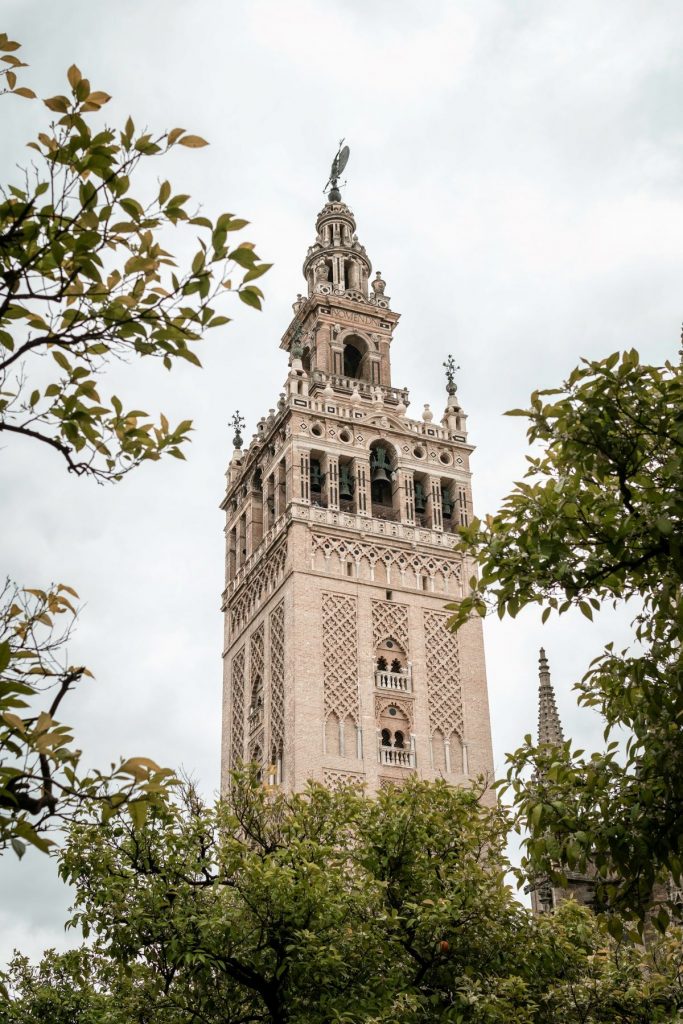
Traveler’s tip: The Seville Cathedral is a fascinating site to see in Sevilla. But there is so much more to see in this vibrant city. To really dive deep into what makes this city tick, consider taking our Sevilla in a Day Walking Tour. From early Alcazar access and the cathedral to the Jewish Quarter, our local expert guides will provide you with special insight into all this city has to offer.
The weather vane
The tower is impressive enough, but look up and you will see a bronze statue on top. This is El Giraldillo, a bronze weathervane in the form of a woman taking inspiration for classical Greek art, which was popular in the renaissance period.
Due to restoration work, a replica was created so the Giraldo wouldn’t be without its crowning glory for long. You can now see this replica at the entrance to the cathedral in the Puerta del Principe. On this replica, you can easily see the details obscured by distance .
Fun fact: Our beautiful Giraldillo appears in Don Quixote by the revered writer Miguel de Cervantes, who spent time in and around the city and the province of Seville. The brave wannabe knight calls her the giantess of Seville in this passage:
- “Once I was commanded to go and challenge that famous giantess of Seville called the Giralda, who is as brave and strong as made of bronze, and without moving from one place is the most mobile and steadfast woman in the word.”
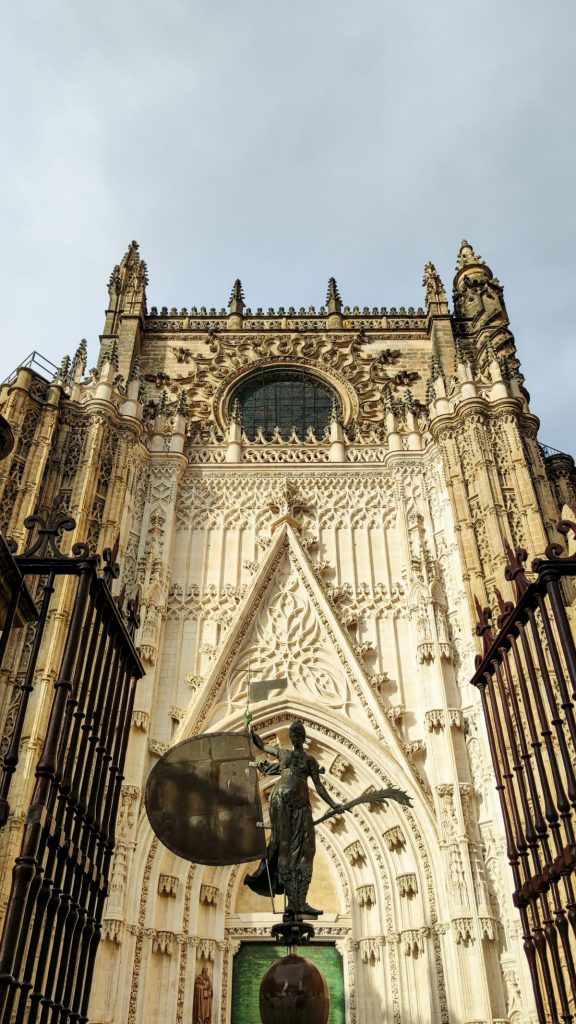
The donkey in the tower
Some of the best views of the city are from the top of the tower. As it is the tallest building in the old town, you have uninterrupted views of the whole ancient city. But being so high, it is quite the climb to the top, but surprisingly, it is not an endless quantity of stairs that stands between you and the top of the bell tower.
It is a ramp that wraps itself around the interior of the tower. Legend has it that the ramp is in place to allow the elderly muezzin easy access to the top of the minaret to call the faithful to prayer. But how would the ramp help?
It was for the donkey to take him up 5 times a day for the call to prayer. Sadly, there is also a much more boring explanation for the ramp, to help take the construction materials up to the top easier. I’m sure you will agree, the donkey legend makes a much better story and there is no reason both can’t be true.
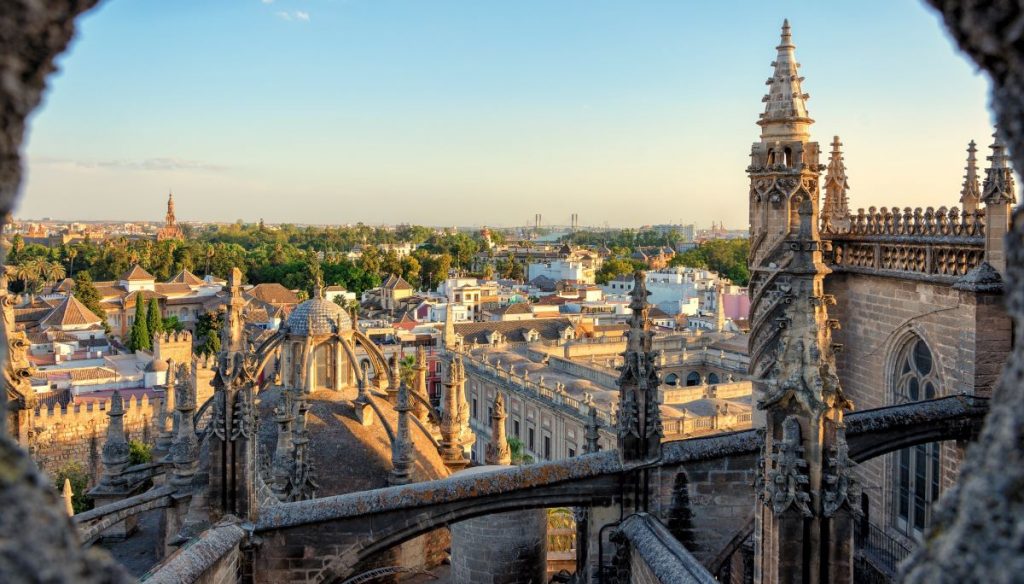
Other Giraldas around the world
With such an iconic design, there’s no wonder that you can see copies of the Giralda around the world. If you want to see what the Giralda would have looked like when first completed, look no further than the Koutoubia, the Giralda’s twin in Marrakech. It is even tinted red, just as Seville’s iconic tower would have been all those years ago.
Closer to home, there are a few copies in Spain:
- Particularly in the former Al Andalus region, and they share the same history of being former minarets converted into church towers.
- Within around an hour from Seville there are similar towers in Ecija and Carmona.
- Going a little further afield, both Badajoz and Tarragona have replicas dating from the early 20th Century.
For our American friends, you too can find some replicas closer to home:
- Seville’s sister city, Kansas City has a half sized replica attached to a shopping center built in the 1960s.
- Miami also has two replicas, the Biltmore Hotel and Freedom Tower.
Other locations with replicas are Puerto Rico and Belgium, with Havana having a replica of el Giraldillo.
Fun fact:
- Seville has an Avenue named after Kansas City, and to match Kansas city having a copy of the Giralda, Avenida Kansas City has a copy of a statue called The Scout, a Native American on horseback.
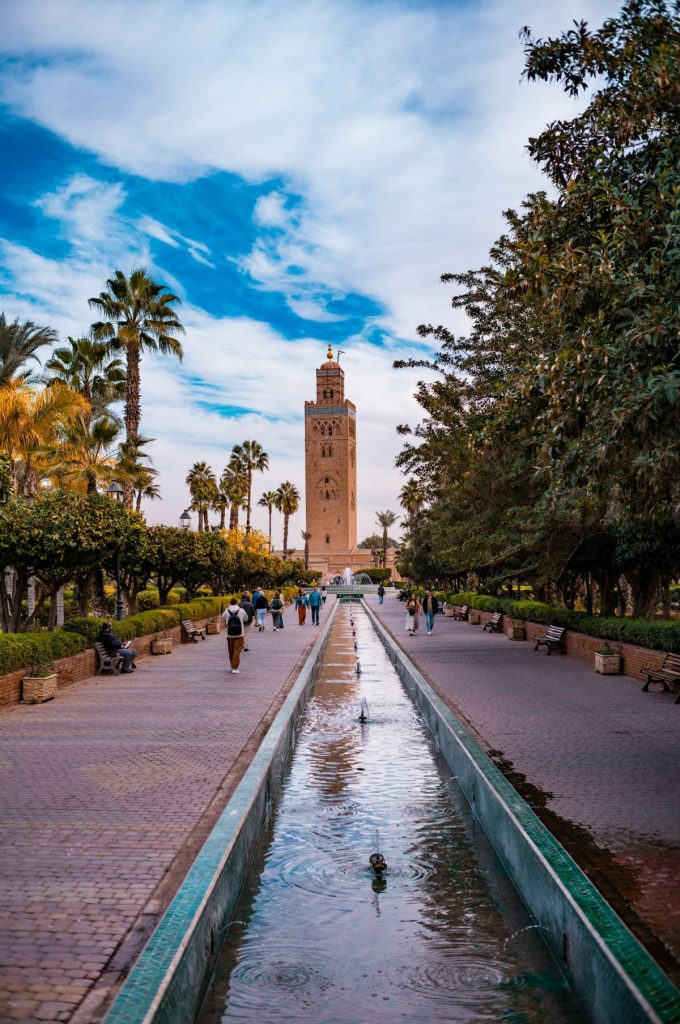
The mosque
As we saw previously, the cathedral is built on the site of a former mosque. Following the reconquest, the mosque was destroyed and in its place stands the magnificent gothic cathedral.
We can still see the influence of this mosque, and even a couple of the original elements, if you know where to look.
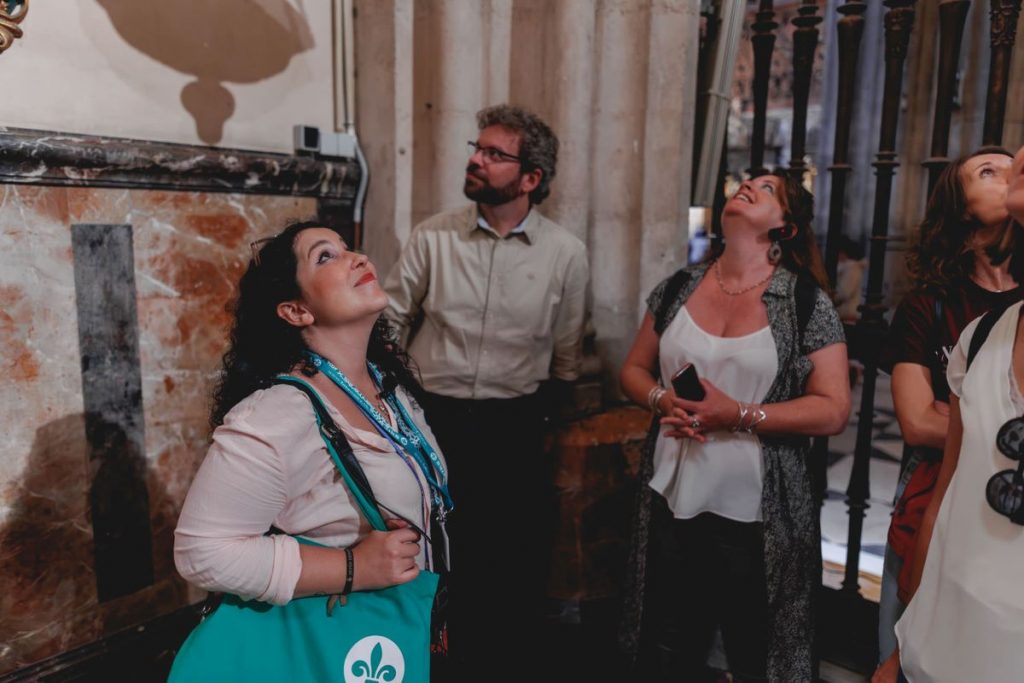
Patio de los Naranjos
If you follow the tour of the cathedral, this is where you exit. This quiet courtyard, known as the Patio de los Naranjos, or the patio of orange trees in English, was the sahn of the mosque.
This is where worshippers would perform the ablutions before praying and the importance of water is highlighted by the fountain. While the Patio has undergone reformations over the centuries, it retains its original character and orange trees which sets this courtyard apart from any other in the city.
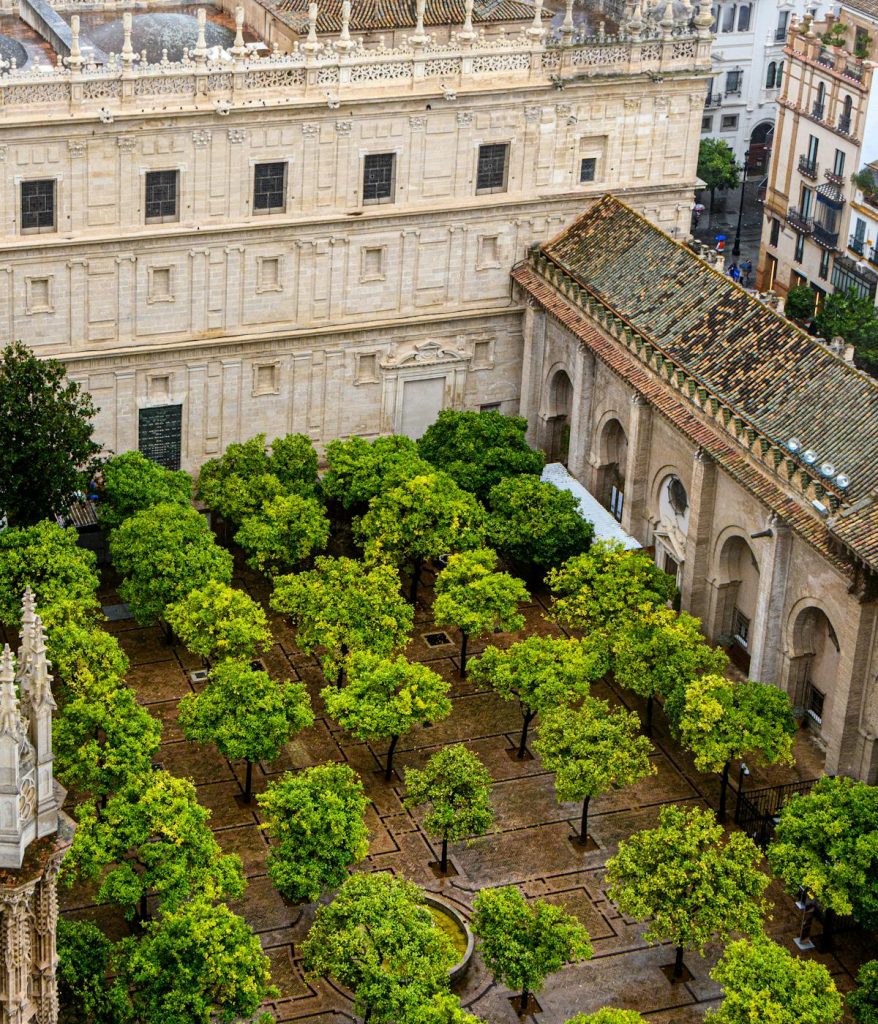
Puerta de Perdón
The door of forgiveness, so called as this was where the faithful believed sinners entered the cathedral to ask forgiveness of their sins. Today this is one of the entrances to the cathedral.
The gateway is a mix of the original almohad and later christian art which became known as the mudejar style, demonstrating the fusion of cultures within Seville.
One of the greatest examples of mudejar architecture and the fusing of the cultures can be found across the Plaza del Triunfo, in the Alcazar. ( For more information on this amazing building, check out our Essential Guide to the Royal Alcazar of Seville.)
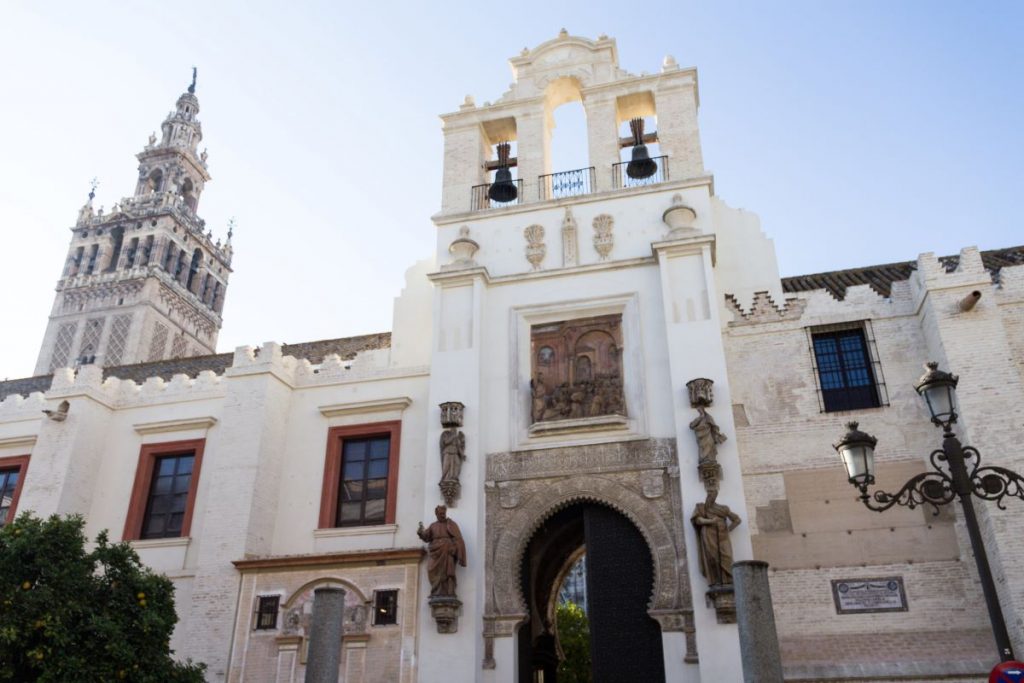
Notable burials
Cathedrals serve as burial grounds for the great, the good, and the notorious, and Seville is no exception. Let’s start with perhaps its most divisive character, Christopher Columbus.
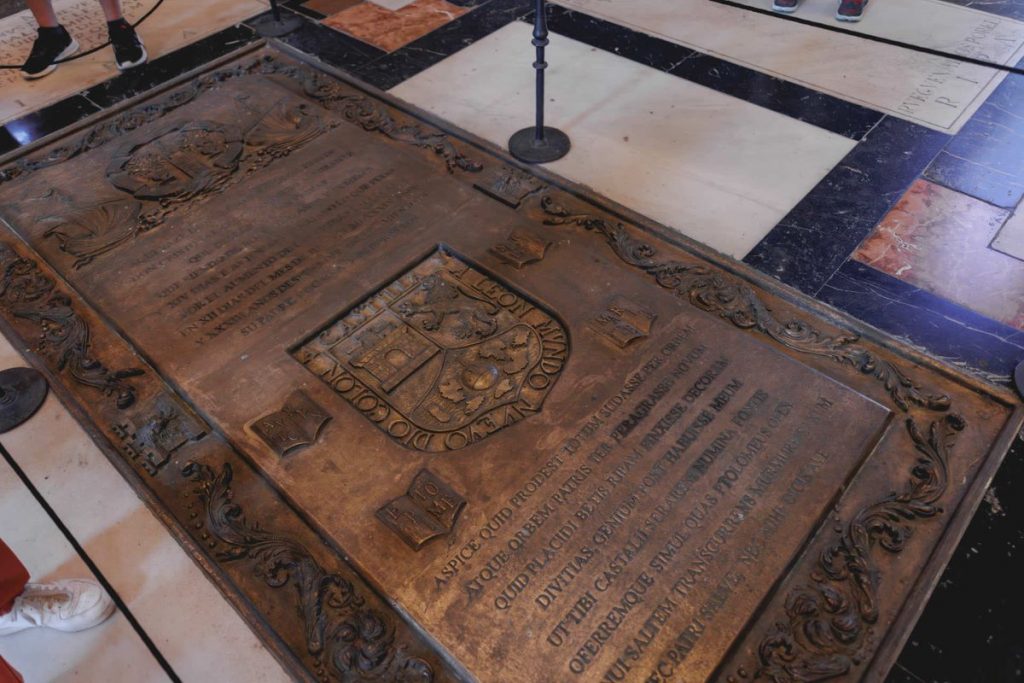
Christopher Columbus
Using his Spanish name Cristobal Colon, he is a controversial figure in history:
- To some: The intrepid explorer breaking rules and discovering the new world and bringing the riches to the city of Seville and, by extension, the rest of Europe.
- To others: Including his original patrons the legendary catholic monarchs, he was a murderous privateer.
Looking at his impressive tomb, one question comes to mind. Why is he being carried?
- The tomb is held aloft by four kings representing the historic four kingdoms of old Spain, Navarre, Aragon, Castile and Leon.
- After the Catholic Monarchs discovered the extent of his blood lust in the Caribbean, they were outraged.
He was forced back to Spain in chains, imprisoned and had his lands and titles removed. While this only lasted a few weeks, his dislike for Spain was set and he did not want his final resting place to be in Spanish soil . After his death his body was moved to several locations, starting in Valladolid to the north, then to the Cartuja monastery in Seville, then to Hispaniola (modern day Dominican Republic) before finally returning to Seville to his final resting place.
For those curious, the Cartuja monastery is open to visitors today, and is the home of the Contemporary Art Museum. There has been controversy that the body in the tomb may not be Cristobal Colón. However, recent DNA testing confirmed that the remains in the Cathedral are indeed his.
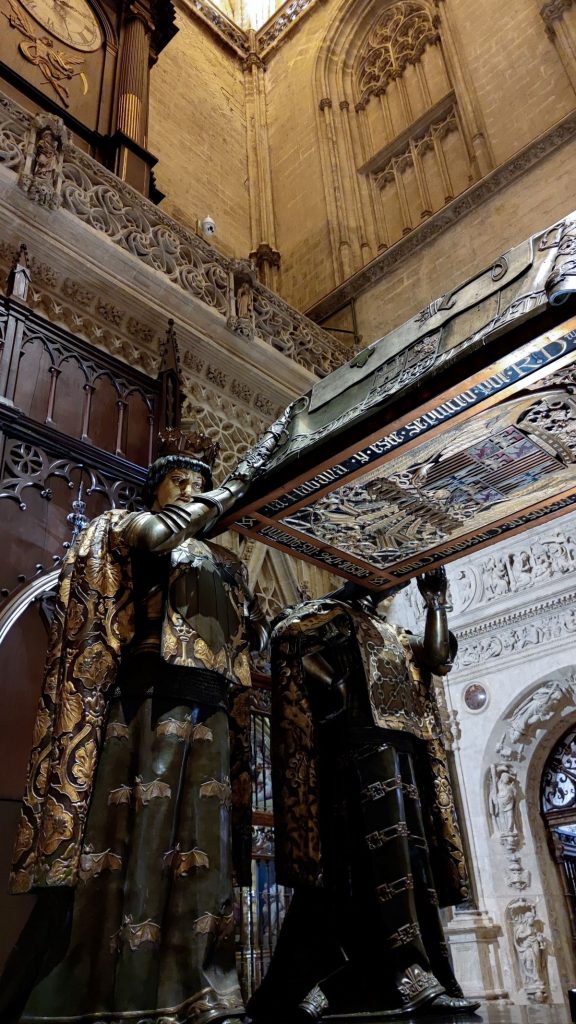
San Fernando
Cathedrals are known for their relics, and Seville’s is no exception. In the treasury there are the highly decorated reliquaries with pieces of San Leandro, San Isidoro, and even the crown of thorns from the crucifixion. But Seville also has something a little rarer than a bone in an ornate container; the incorrupt body of the city’s patron saint San Fernando.
San Fernando was the King responsible for the reconquest of Seville in 1248. Following his death in 1252 Fernando III was buried in the crypt, wearing simple monks robes at the foot of the Virgen de los Reyes as he wished. He has been moved several times due to his son wanting a more regal burial on remodeling of the cathedral, but took to his final resting place in 1729.
Most of the year, it looks like many tombs of long deceased royalty. However, on his feast day of 30th May, the anniversary of his death, the sides are opened to reveal the body of the Saint.

Interesting objects
The crocodile
A great many things can be discovered in this fine city simply by looking up. On entering the cathedral via the Patio de los Naranjos, allow your eyes to wander upwards and you will see an eclectic collection of objects. There is an elephant’s tusk, a ceremonial baton, an oversized horse’s bridle, and the strangest of all, a large wooden crocodile known affectionately as the legend of the crocodile, el largato de la catedral.
The wooden statue of today was placed in 1752 to replace the original mummified crocodile. But how did a crocodile wind up in Seville, so far from its home in Egypt? After the reconquest, the Sultan of Egypt sent an embassy to Seville after learning of the power and influence of the castile crown, which included various riches and wild animals.
Part of the reason for this was to ask for the hand of Princess Berenguela. The Marriage proposal was tactfully declined but the menagerie remained in Seville, with the crocodile living out its life in one of the pools of the Alcazar. After its death it was stuffed and placed in the Patio de Naranjos, where its wooden stand-in is today.
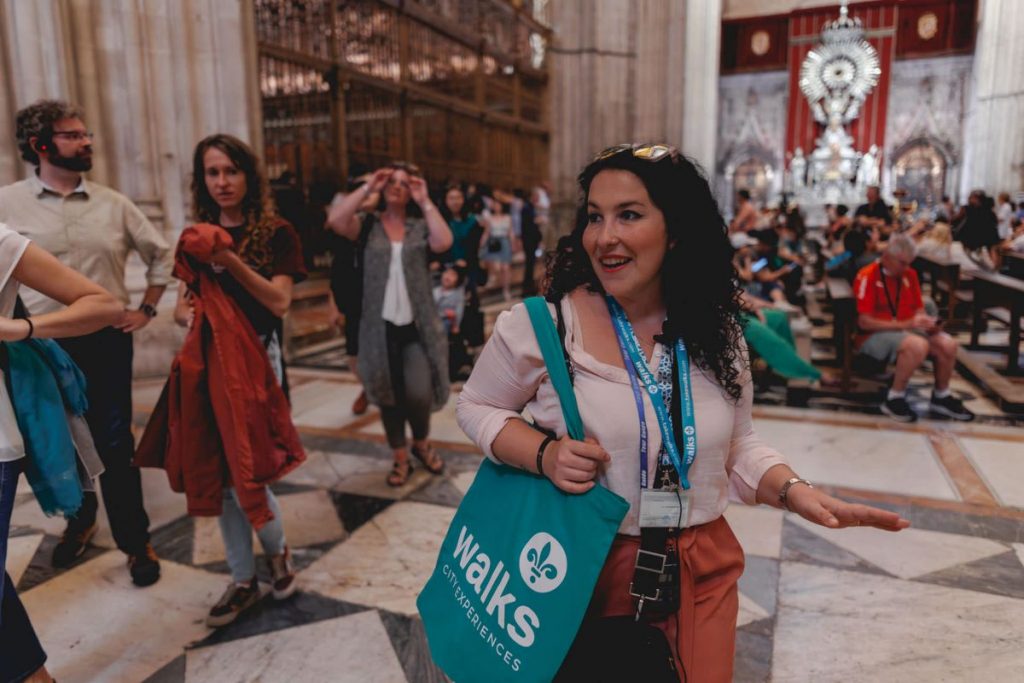
Sword and banner of San Fernando
San Fernando is the Patron Saint of Seville. As we saw earlier, he is buried here, and displayed here each year on the anniversary of his death. But there is another artifact of his here. And for aficionados of medieval arms and swords, it is something truly spectacular.
The cathedral houses his sword, la lobera, or in English, the huntress of wolves. This sword became a symbol of his power, so much so that since 1255, on the 25th of November, the anniversary of the reconquest of Seville, it is paraded around the Cathedral, along with the pendant of San Fernando.
The banner flown during the Siege of Seville, remains preserved and venerated in the city. Having undergone restoration in 1999, it is kept in a carefully controlled climate next to the capilla de bautismo.
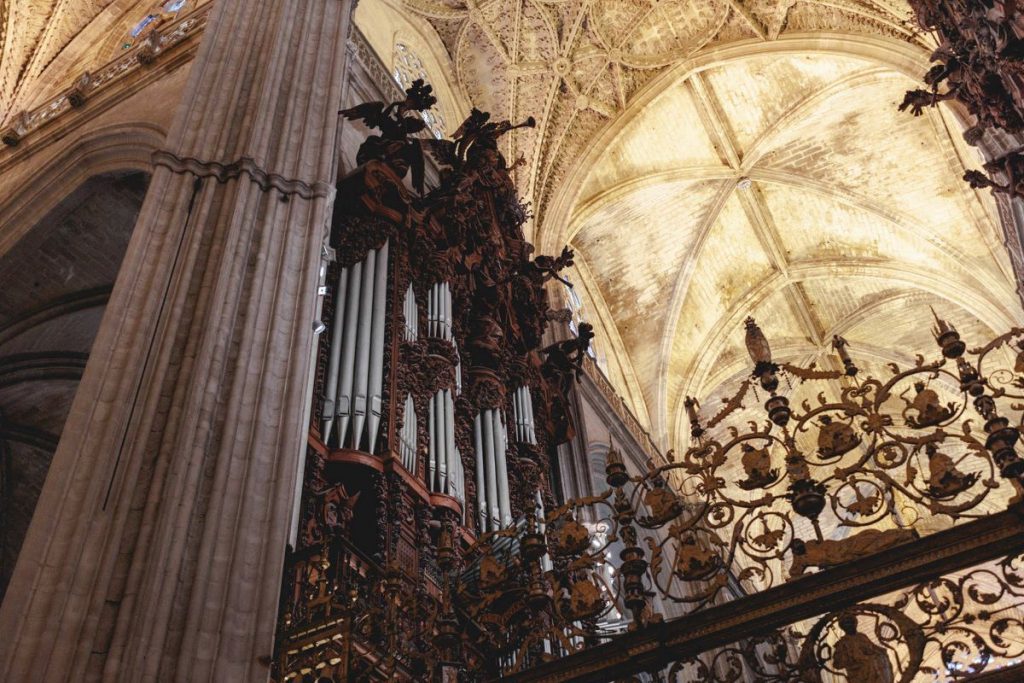
The columns
Let us step outside the Cathedral walls for a moment and take a walk around the perimeter. Surrounding the Cathedral are a series of columns. In the past these served a very important purpose, they marked the edge of the two legal systems.
Inside this ring of stones, ecclesiastical law ruled, outside, it was the civil law that must be obeyed. For those seeking asylum and sanctuary, they were safe from the city officials, the alguaciles, who were not permitted within those limits.
The oldest columns run from la Giralda to the Puerta de San Miguel. Most were brought from the nearby Roman settlement of Italica, well worth a trip for those interested in ancient history.
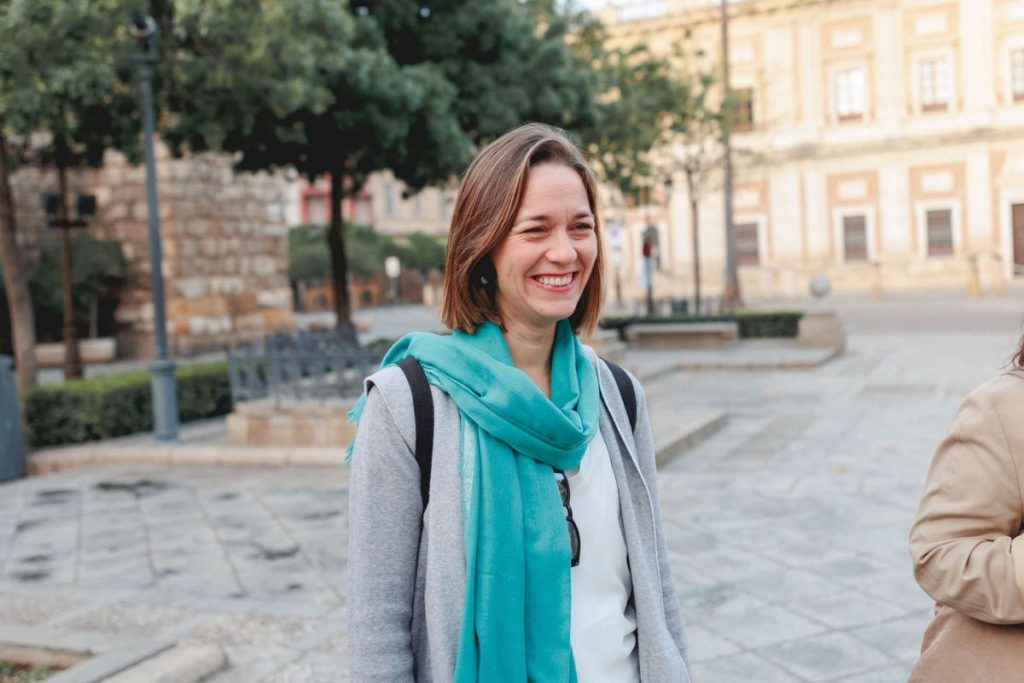
Keys to the city
Seville was once a walled city. As you wander around, you can see where some of the walls remain, most clearly in the jardin de Murillo and around the Arco de la Macarena. A walled city needs keys, even if they are purely ceremonial.
The story goes, following the Siege of Seville, the ruler of Seville handed the keys to the city to King Fernando III, then fled to Ceuta. The passing of the keys marks a peaceful transition of power and seals into the history of the city the concept of the three cultures, las tres culturas of the Muslim, Jewish, and Christian populations which shaped the art and culture of Andalusia.
The keys we see today are inscribed, one in Latin and the other in Arabic. In Latin it reads “God will open, King will enter” and in Arabic “All power belongs to God.”
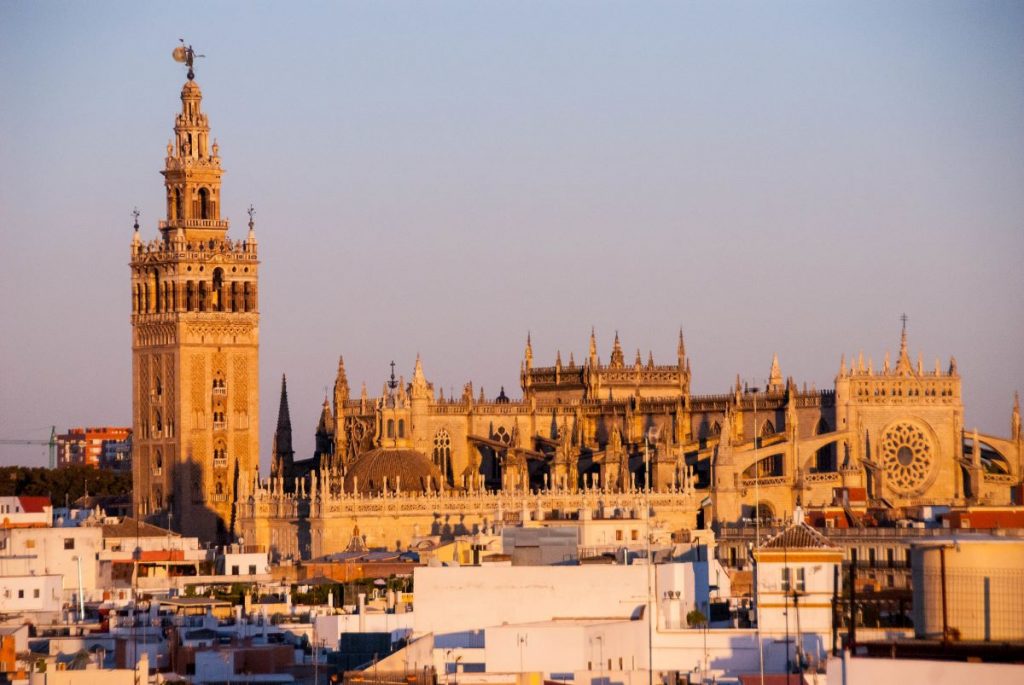
Explore this fascinating location, along with Seville’s other crowning glory, the Real Alcazar on our Best of Seville Walking Tour. Find out more about the three cultures, how the royals used to live, and more with our expert guides.
